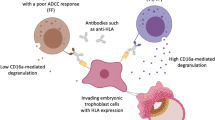Abstract
Purpose
The M2 haplotype in ANXA5 as well as antitrophoblast antibodies predispose to recurrent pregnancy loss (RPL). Since M2/ANXA5 can be a factor for development of antiphospholipid antibodies (aPL), this study aimed to trace a possible association of M2 with antitrophoblast antibodies.
Methods
One hundred patients with two or more consecutive, idiopathic RPLs were divided in two subgroups, JEG-3+ (n = 42) and JEG-3− (n = 58), according to the anti-JEG-3 reactivity measured in subjects’ sera. Both subgroups were genotyped for ANXA5 promoter haplotypes and genetic frequencies were compared to available fertile and control populations, as well as within the subgroups.
Results
M2/ANXA5 was generally enriched in the JEG-3 screened cohort of RPL patients in comparison to fertile and population controls. Despite the relatively higher abundance of the haplotype in the JEG-3− sample as compared to JEG-3+ patients and in the JEG-3− primary RPL subset in particular, compared to the rest of patients, there was no statistically significant difference between both, JEG-3− and JEG-3+ subgroups.
Conclusion
It appears that the haplotype M2/ANXA5 is not associated with the presence of anti-trophoblast antibodies. Our finding indicates that anti-trophoblast antibodies are a class of molecules that differ from aPL and from anti-b2-GPI antibodies, apparently not directed to same or similar epitopes that aPL and anti-b2-GPI would recognize.
Similar content being viewed by others
References
Bennett SA, Bagot CN, Arya R. Pregnancy loss and thrombophilia: the elusive link. Br J Haematol. 2012;157:529–42.
Bogdanova N, Baleva M, Kremensky I, Markoff A. The annexin A5 protective shield model revisited: inherited carriage of the M2/ANXA5 haplotype in placenta as a predisposing factor for the development of obstetric antiphospholipid antibodies. Lupus. 2012;21:796–8.
Bogdanova N, Horst J, Chlystun M, Croucher PJ, Nebel A, Bohring A, et al. A common haplotype of the annexin A5 (ANXA5) gene promoter is associated with recurrent pregnancy loss. Hum Mol Genet. 2007;16:573–8.
Bouter A, Gounou C, Bérat R, Tan S, Gallois B, Granier T, et al. Annexin-A5 assembled into two-dimensional arrays promotes cell membrane repair. Nat Commun. 2011;2:270.
Chinni E, Tiscia GL, Colaizzo D, Vergura P, Margaglione M, Grandone E. Annexin V expression in human placenta is influenced by the carriage of the common haplotype M2. Fertil Steril. 2010;91:940–2.
de Laat B, Wu XX, van Lummel M, Derksen RH, de Groot PG, Rand JH. Correlation between antiphospholipid antibodies that recognize domain I of beta2-glycoprotein I and a reduction in the anticoagulant activity of annexin A5. Blood. 2007;109:1490–4.
Falush D, Stephens M, Pritchard JK. Inference of population structure: extensions to linked loci and correlated allele frequencies. Genetics. 2003;164:1657–87.
Galarza-Maldonado C, Kourilovitch MR, Pérez-Fernández OM, Gaybor M, Cordero C, Cabrera S, et al. Obstetric antiphospholipid syndrome. Autoimmun Rev. 2012;11:288–95.
Hughes G. Hughes Syndrome: the antiphospholipid syndrome–a clinical overview. Clin Rev Allergy Immunol. 2007;32:3–12.
Huppertz B, Berghold VM, Kawaguchi R, Gauster M. A variety of opportunities for immune interactions during trophoblast development and invasion. Am J Reprod Immunol. 2012;67:349–57.
Johnson PM, Barnes RM, Hart CA, Francis WJ. Determinants of immunological responsiveness in recurrent spontaneous abortion. Transplantation. 1984;38:280–4.
Kishore R, Agarwal S, Halder A, Das V, Shukla BR, Agarwal SS. HLA sharing, anti-paternal cytotoxic antibodies and MLR blocking factors in women with recurrent spontaneous abortion. J Obstet Gynaecol Res. 1996;22:177–83.
Koga K, Cardenas I, Aldo P, Abrahams VM, Peng B, Fill S, et al. Activation of TLR3 in the trophoblast is associated with preterm delivery. Am J Reprod Immunol. 2009;61:196–212.
Krawczak M, Nikolaus S, von Eberstein H, Croucher PJP, El Mokhtari NE, Schreiber S. PopGen: population-based recruitment of patients and controls for the analysis of complex genotype-phenotype relationships. J Commun Genet. 2006;9:55–61.
Krikun G, Lockwood CJ, Wu XX, Zhou XD, Guller S, Calandri C, et al. The expression of the placental anticoagulant protein, annexin V, by villous trophoblasts: immunolocalization and in vitro regulation. Placenta. 1994;15:601–12.
Li TC, Makris M, Tomsu M, Tuckerman E, Laird S. Recurrent miscarriage: aetiology, management and prognosis. Human Reprod Update. 2002;8:463–81.
Markoff A, Gerdes S, Feldner S, Bogdanova N, Gerke V, Grandone E. Reduced allele specific annexin A5 mRNA levels in placentas carrying the M2/ANXA5 allele. Placenta. 2010;31:937–40.
McIntyre JA, Faulk WP. Recurrent spontaneous abortion in human pregnancy: results of immunogenetical, cellular and humoral studies. Am J Reprod Immunol. 1983;4:165–70.
McIntyre JA, Faulk WP, Nichols-Johnson VR, Taylor CG. Immunological testing and immunotherapy in recurrent spontaneous abortion. Obstet Gynecol. 1986;67:169–75.
Miyakis S, Lockshin MD, Atsumi T, Branch DW, Brey RL, Cervera R, et al. International consensus statement on an update of the classification criteria for definite antiphospholipid syndrome (APS). J Thromb Haemost. 2006;4:295–06.
Miyamura H, Nishizawa H, Ota S, Suzuki M, Inagaki A, Egusa H, et al. Polymorphisms in the annexin A5 gene promoter in Japanese women with recurrent pregnancy loss. Mol Hum Reprod. 2011;17:447–52.
Pritchard JK, Stephens M, Donnelly P. Inference of population structure using multilocus genotype data. Genetics. 2000;155:945–59.
Quenby S, Farquharson RG, Dawood F, Hughes AM, Topping J. Recurrent miscarriage and long-term thrombosis risk: a case–control study. Hum Reprod. 2005;20:1729–32.
Rand JH, Arslan AA, Wu XX, Wein R, Mulholland J, Shah M, et al. Reduction of circulating annexin A5 levels and resistance to annexin A5 anticoagulant activity in women with recurrent spontaneous pregnancy losses. Am J Obstet Gynecol. 2006;194:182–8.
Rand JH, Wu XX. Antibody-mediated disruption of the annexin-V antithrombotic shield: a new mechanism for thrombosis in the antiphospholipid syndrome. Thromb Haemost. 1999;82:649–55.
Rand JH, Wu XX, Guller S, Scher J, Andree HA, Lockwood CJ. Antiphospholipid immunoglobulin G antibodies reduce annexin-V levels on syncytiotrophoblast apical membranes and in culture media of placental villi. Am J Obstet Gynecol. 1997;177:918–23.
Raymond M, Rousset F. GENEPOP (version 1.2): population genetics software for exact tests and ecumenicism. J Heredity. 1995;86:248–9.
Rogenhofer N, Ochsenkühn R, Von Schönfeldt V, Assef RB, Thaler CJ. Anti-trophoblast antibodies associated with recurrent miscarriages. Fertil Steril. 2012;97:361–6.
Romisch J, Seiffge D, Reiner G, Paques EP, Heimburger N. In-vivo antithrombotic potency of placenta protein 4 (annexin V). Thromb Res. 1991;61:93–104.
Rotterdam ESHRE ⁄ ASRM-Sponsored PCOS Consensus Workshop Group. Revised 2003 consensus on diagnostic criteria and long-term health risks related to polycystic ovary syndrome. Fertil Steril. 2004;81:19–25.
Rowe P, Comhaire F, Hargreave T, Mellows H. WHO manual for the standardized investigation and diagnosis of the infertile couple. World Health Organization, Cambridge University Press. 1993.
Shu F, Sugimura M, Kanayama N, Kobayashi H, Kobayashi T, Terao T. Immunohistochemical study of annexin V expression in placentae of preeclampsia. Gynecol Obstet Invest. 2000;49:17–23.
Sifakis S, Soufla G, Koukoura O, Soulitzis N, Koutroulakis D, Maiz N, et al. Decreased annexin A5 mRNA placental expression in pregnancies complicated by fetal growth restriction. Thromb Res. 2010;125:326–31.
Thiagarajan P, Tait J. Binding of annexin V/placental anticoagulant protein I to platelets. Evidence for phosphatidylserine exposure in the procoagulant response of activated platelets. J Biol Chem. 1990;265:17420–3.
Tiscia G, Colaizzo D, Chinni E, Pisanelli D, Sciannamè N, Favuzzi G, et al. Haplotype M2 in the annexin A5 (ANXA5) gene and the occurrence of obstetric complications. Thromb Haemost. 2009;102:309–13.
Vinatier D, Dufour P, Cosson M, Houpeau JL. Antiphospholipid syndrome and recurrent miscarriages. Eur J Obstet Gynecol Reprod Biol. 2001;96:37–50.
Acknowledgments
The authors wish to acknowledge the continuous support of IZKF Muenster for this study.
Conflict of interest
The Authors wish to declare no conflict of interest.
Author information
Authors and Affiliations
Corresponding author
Additional information
Capsule
M2/ANXA5 carriage appears enriched in a subgroup of RPL patients with primary recurrent miscarriage and negative for antitrophoblast antibodies that is indicative of the haplotype's role as independent risk factor although the observed difference is not statistically significant.
Rights and permissions
About this article
Cite this article
Rogenhofer, N., Engels, L., Bogdanova, N. et al. The haplotype M2 of the ANXA5 gene is not associated with antitrophoblast antibodies. J Assist Reprod Genet 30, 711–716 (2013). https://doi.org/10.1007/s10815-013-9978-0
Received:
Accepted:
Published:
Issue Date:
DOI: https://doi.org/10.1007/s10815-013-9978-0




